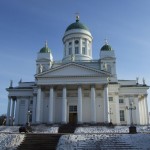Helsinki – the White Capital of the North
Helsinki lies on the shore of the Finnish Bay, but some parts of its territory extend to the offshore islands. For the last decades the capital has grown so much that it merged with its suburbs — one of them Swedish (in the North) and the other one Finnish (in the North-East). Consequently, now Big Helsinki includes three cities: Helsinki, Espoo (or Esbo) and Vantaa (or Vanda).
Unlike in many other cities of Europe identifying different areas of the city by the closest metro stations is not practiced here, because the metro covers only a very limited part of the territory. The ‘identification marks” are the railway station, the main street of Helsinki – Mannerheim’s avenue (Mannerheimintie), and the names of districts and islands.
Finland is officially a bilingual state; therefore all the sign boards, inscriptions, and guide signs are made in two languages: the first is Finnish and the second is Swedish. The names of tourist attractions (museums, restaurants, hotels, and so forth) are also often given in English. Most tram and bus routes start from or go by the railway station. This place is considered to be the center of the city.
Finland’s capital, Helsinki (Helsinki – in Finnish, Helsingfors – in Swedish) – is a modern city with the population of 525 thousand citizens. The city is located on the shore of the Finland Bay. It was founded by king of Sweden Gustav Vasa in 1550 in the mouth of Vantaa River. In the course of time Helsinki has moved closer to the sea where it is now. The period of Swedish dominion has almost left no signs in the architecture of the city. The wooden constructions of Gustav Vasa were destroyed by fires and time. Within the boundary of Helsinki only the island fortress Sveaborg and two Middle Age stone churches, erected a century before the city was founded, belong to the Swedish epoch.
Helsinki remained a small settlement until 1812 when, after the Finnish lands were conquered by the Russian Empire, by a decree of the Russian Tsar Alexander I, the capital of the Grand Duchy of Finland was moved from Turku to this city. From this time on the new city began to grow rapidly. Johan Albrecht Eerenstrem was commissioned to develop the construction plan. German architect Carl Ludwig Engel, who prior to that worked in Tallinn and performed a few private orders in Turku, was invited to carry out the architectural part of the project. The task of creating an elegant magnificent capital was brilliantly fulfilled. It is said about Helsinki, which is built in the Empire style, that it is the last city in Europe planned as one whole to make it a real masterpiece.

